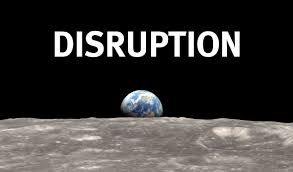Friendly fire in a military context is often associated with tragic fatalities. However, it can also serve as welcome reinforcements, shift the momentum and win the battle.
Disruption is ‘friendly fire’ and will either be the thing that kills you or the catalyst in winning the battle.
 The not so simple reality is that disruption is now part of the strategic leader’s landscape. The one thing you can be certain of is that your plan to move forward will encounter disruption and the likelihood is that the disruption encountered will be from an unexpected direction. For banking the risk might be posed by Mark Zuckerberg’s Facebook applying for a banking licence in Ireland only last year. Given that Facebook has access to some 1.4 million users the threat to banking’s traditional means of facilitating money transfers is obvious. And it doesn’t stop there: other ‘non-banking’ institutions are making inroads to the traditional market as consumers move to easy to use digital means of processing payments. Starbucks reputedly conducts 16% of it’s US transactions through it’s own mobile payment app and the story of M-Pesa in Kenya is well documented.
The not so simple reality is that disruption is now part of the strategic leader’s landscape. The one thing you can be certain of is that your plan to move forward will encounter disruption and the likelihood is that the disruption encountered will be from an unexpected direction. For banking the risk might be posed by Mark Zuckerberg’s Facebook applying for a banking licence in Ireland only last year. Given that Facebook has access to some 1.4 million users the threat to banking’s traditional means of facilitating money transfers is obvious. And it doesn’t stop there: other ‘non-banking’ institutions are making inroads to the traditional market as consumers move to easy to use digital means of processing payments. Starbucks reputedly conducts 16% of it’s US transactions through it’s own mobile payment app and the story of M-Pesa in Kenya is well documented.
The disruption of the growing online channel in retailing could see convenience stores in the future becoming pick-up points for multiple goods delivered through online purchasing as delivery becomes the new challenge to online shopping. The under the skin micro-chip tagging for identification that is already in use, will disrupt multiple facets of current security and access control procedures and the supporting infrastructure.
The new generation of robots threatens many jobs, a threat that for many remains completely in their blind spot. These new robots being produced by ABB Ltd, a Zurich based maker of automated equipment and Fanuc Corp of Japan, are more flexible, stronger and smarter. They can help assemble products such as tablet computers, laptops and smartphones and in so doing perform intricate tasks that in the recent past were beyond their capabilities. See how even my language (‘their capabilities’) is affording these new robots more humane status! This reality serves as a massive threat to the ‘low cost’ labour used in countries such as China. With these latest innovations robots have been liberated from the cages in which they were and there is no limit to the future possibilities…and disruptions. The Economist predicts that over the next two decades 47% of current jobs will disappear due to technology.
3-D printing has very rapidly shifted from the ‘edge’ of something more akin to a sci-fi plot to a very real disruptive force. Where once people were surprised by the 3-D printer, the only surprise now is the seemingly limitless abilities such innovation processes. From human organs to houses; from guns to food…anything it seems can be printed. In January, Chinese company Winsun unveiled a 1,100sqm villa it had printed in a month with only eight people needed for the task. The Mars adventure is dependent on the ability to print whatever is needed, especially the human habitat that will be required. NASA is experimenting with this technology to build lunar modules for the moon. After all getting bricks to Mars is something not even NASA can do! The early experiments in this are being done as we speak. In December, it took astronaut Barry Wilmore only three hours to print out the first tool made in space (a wench). Scientists at NASA are excited by the possibilities: there may be things that can be made (printed) in zero gravity that cannot be done on earth.
Disruption. Friend or enemy? Well, smart leaders understand disruption as welcome friendly fire. Smart leaders don’t wait for the disruption they instigate it. Smart leaders build teams and organisations that learn how to thrive in a world of disruption; they learn how to build stability in such instability. They see disruption as an opportunity and not a threat.
And all that is a lot easier written than it is practiced! We will have to dismantle the prevailing mind-sets around organisational stability and unlearn much of what constitutes conventional wisdom when it comes to organisational ‘best practice’. Smart leaders will look to different indicators and understand the importance of failure as a necessary part of the innovation process. Smart leaders will be comfortable challenging the existing assumptions underpinning their business model and they will understand that unlearning, adaptability and strategic agility starts with them.
Here might be some helpful questions to be asking:
• So what is likely to be your (next big) disruption?
• How much of your conversation and energy with your team is spend trying to ward off disruption or preserve the status quo?
• Could this time and energy not be better spent changing your mind-set toward the inevitable disruption and through that, transforming what happens next?
• What have you learnt from the last major disruption experienced – not from a solutions point of view but how you and others dealt with it?
Disruption. Put it on your next Exco agenda and gauge your team’s readiness to become futurefit.

